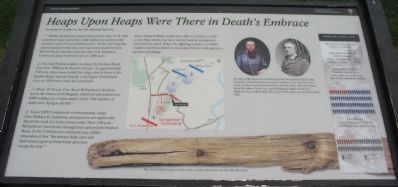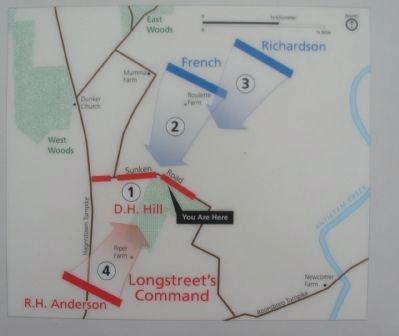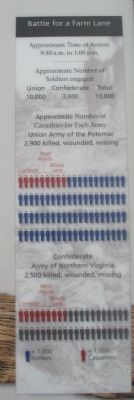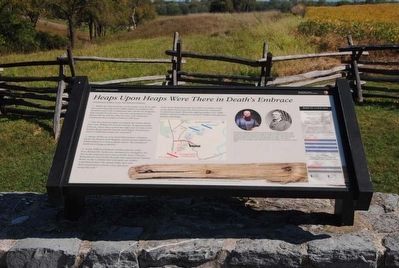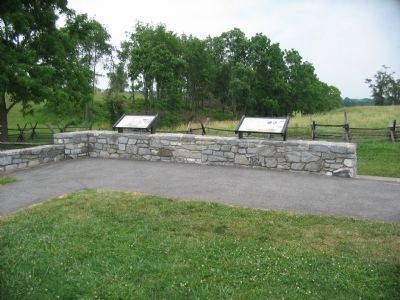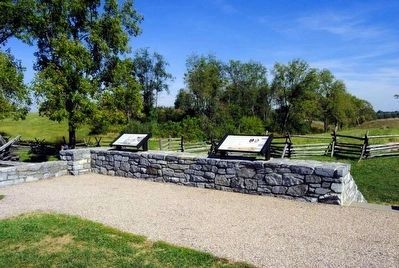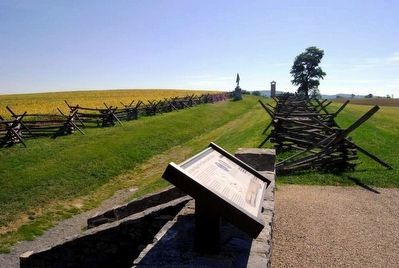Near Sharpsburg in Washington County, Maryland — The American Northeast (Mid-Atlantic)
Heaps Upon Heaps Were There in Death's Embrace
Confederate Soldier in the 3rd Alabama Infantry
(1) Within the first few hours of the battle, Gen. D.H. Hill sent more than half of his 5,000 soldiers to reinforce the northern end of the Confederate line. Of the two brigades that remained in the lane, one was commanded by Gen. Robert Rodes and the other by Gen. G.B. Anderson. Combined, they numbered about 2,200 men.
(2) The first Federal soldiers to attack the Sunken Road were Gen. William H. French's troops. At approximately 9:30 a.m., these men crested the ridges just in front of the Sunken Road, and the bloody work began. French had close to 5,000 men under his command.
(3) About 10:30 a.m. Gen. Israel Richardson's division, led by the famous Irish Brigade, advanced and added over 4,000 soldiers to a Union attack where "the missiles of death were flying so thickly."
(4) Some 3,800 Confederate reinforcements, under Gen. Richard H. Anderson, attempted to strengthen the line in the road, but were unsuccessful. Near 1:00 p.m., Richardson's men broke through and captured the Sunken Road. As the Confederates retreated, one soldier remembered that "the minnie balls, shot and shell rained upon us from every direction except the rear."
Some of the Federal troops were able to continue south to the Piper Farm, but were driven back by a desperate Confederate stand. When the fighting ended, over 5,000 soldiers had been killed or wounded. Neither side gained a decisive advantage.
During the fighting around the Sunken Road, two generals fell mortally wounded. Confederate Gen. George B. Anderson was shot in the ankle and died from infection a month after the battle. After the Sunken Road had fallen, Union Gen. Israel Richardson was hit by a fragment of an artillery shell. He died at the Pry House in early November 1862.
Battle for a Farm Lane
Approximate Time of Action: 9:30 a.m. to 1:00 p.m.
Approximate Number of Soldiers engaged
Union 10,000
Confederate 3,000
Total 13,000
Approximate Number of Casualties for Each Army
Union Army of the Potomac 2,900 killed, wounded, missing
Confederate Army of Northern Virginia
2,500 killed, wounded, missing
Erected 2009 by Antietam National Battlefield - National Park Service - U.S. Department of the Interior.
Topics. This historical marker is listed in this topic list: War, US Civil. A significant historical date for this entry is September 17, 1862.
Location. 39° 28.259′ N, 77° 44.36′ W. Marker is near Sharpsburg, Maryland, in Washington County. Marker is on Bloody Lane, on the left when traveling east. Located at the Sunken Road overlook stop. Touch for map. Marker is in this post office area: Sharpsburg MD 21782, United States of America. Touch for directions.
Other nearby markers. At least 10 other markers are within walking distance of this marker. "The End of the Confederacy Was In Sight" (here, next to this marker); "These Men Are Going to Stay Here" (here, next to this marker); A Simple Farm Lane Changed Forever (here, next to this marker); The 14th Indiana Infantry (within shouting distance of this marker); 8th Ohio Regiment (within shouting distance of this marker); 132nd Pennsylvania Volunteer Infantry (within shouting distance of this marker); Second Army Corps (about 300 feet away, measured in a direct line); Jackson's Command (about 300 feet away); Brigadier General George B. Anderson (about 400 feet away); a different marker also named Second Army Corps (about 400 feet away). Touch for a list and map of all markers in Sharpsburg.
More about this marker. In the left center is a map showing the actions described in the text, referenced by paragraph number. In the right center are portraits of Gens. G.B. Anderson and Israel Richardson. At the bottom is a photo of a rail fence section. This shot riddled section of fence rail is said to have been found at Bloody Lane.
Related marker. Click here for another marker that is related to this marker. This entry replaced a previous marker located at the same spot titled "The End of the Confederacy was in Sight."
Also see . . .
1. Antietam Battlefield. National Park Service site. (Submitted on July 11, 2009, by Craig Swain of Leesburg, Virginia.)
2. George B. Anderson. George Burgwyn Anderson (April 12, 1831 – October 16, 1862) was a career military officer, serving first in the antebellum U.S. Army and then dying from wounds inflicted during the American Civil War while a general officer in the Confederate Army. He was among six generals killed or mortally wounded at the Battle of Antietam in September 1862. (Submitted on September 27, 2015, by Brian Scott of Anderson, South Carolina.)
3. Israel B. Richardson. Israel Bush Richardson (December 26, 1815 – November 3, 1862) was a United States Army officer during the Mexican-American War and American Civil War, where he was a major general in the Union Army. Nicknamed "Fighting Dick" for his prowess on the battlefield, he was mortally wounded at the Battle of Antietam near Sharpsburg, Maryland. (Submitted on September 27, 2015, by Brian Scott of Anderson, South Carolina.)
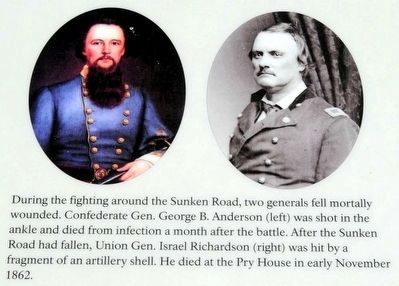
Photographed By Brian Scott, September 19, 2015
5. Heaps Upon Heaps Were There in Death's Embrace Marker
During the fighting around the Sunken Road, two generals fell mortally wounded. Confederate Gen. George B. Anderson (left) was shot in the ankle and died from infection a month after the battle. After the Sunken Road had fallen, Union Gen. Israel Richardson (right) was hit by a fragment of an artillery shell. He died at the Pry House in early November 1862.
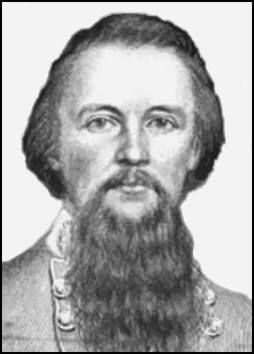
Photographed By Brian Scott
9. Brig. General George B. Anderson (1831-1862)
During the Battle of Antietam, Anderson's North Carolinians defended a portion of the Sunken Road (known as "Bloody Lane") against repeated Union attacks. A Minié ball struck Anderson near his ankle, injuring it badly. Anderson was transported to Shepherdstown and then by wagon up the Shenandoah Valley to Staunton, Virginia, to recuperate. He was eventually shipped by train to Raleigh, North Carolina, where he died following surgery to amputate the infected foot.
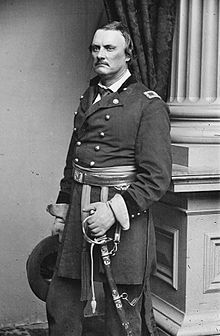
Photographed By Brian Scott
10. Major General Israel B. Richardson (1815-1862)
Richardson was treated at a field hospital. His wound was not considered life-threatening, and he was given a room in Maj. Gen. George B. McClellan's headquarters, the Pry House. President Abraham Lincoln paid his respects to the wounded Richardson during a visit to the battlefield in October. However, infection set in, and then pneumonia, which claimed the life of the popular general in early November.
Credits. This page was last revised on April 1, 2022. It was originally submitted on July 11, 2009, by Craig Swain of Leesburg, Virginia. This page has been viewed 1,176 times since then and 13 times this year. Photos: 1, 2, 3. submitted on July 11, 2009, by Craig Swain of Leesburg, Virginia. 4, 5. submitted on September 27, 2015, by Brian Scott of Anderson, South Carolina. 6. submitted on July 11, 2009, by Craig Swain of Leesburg, Virginia. 7, 8, 9, 10. submitted on September 27, 2015, by Brian Scott of Anderson, South Carolina.
